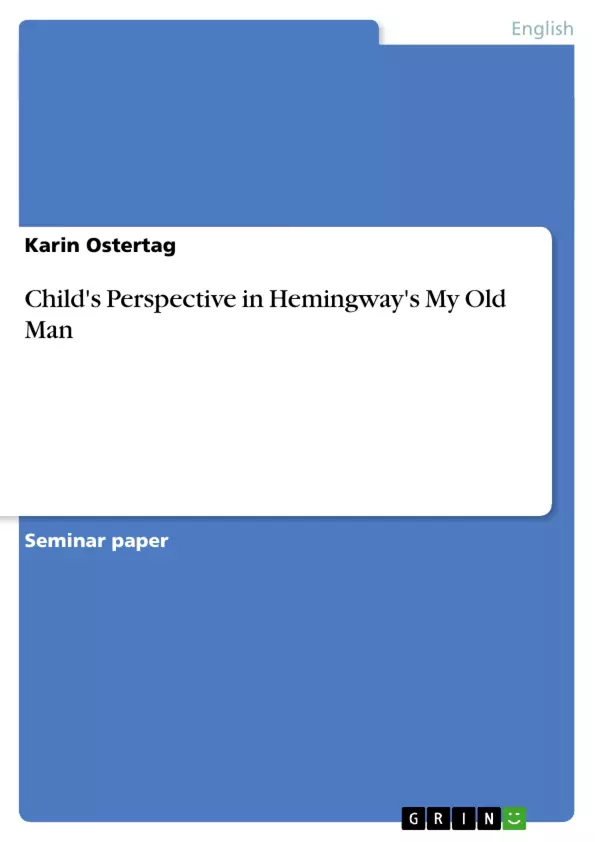[...]
The first aspect is stressed especially by Jackson J. Benson when he compares "My Old
Man" and Anderson's "I Want To Know Why" similar in view, subject, plot, tone, and
diction.
"Both stories are about boys in a race track setting. Both boys admire an older man, are
influenced by him, and then find their admiration betrayed. Both boys are left puzzled and
hurt by the experience. Each story is told in the first person by the boy who is characterized
by slightly broken grammar and the use of adolescent slang 'gee', 'gosh', and 'swell'."
(Benson, 273)
Christian Messinger argues that "Anderson sensed both the longing for success that
gripped track people and the disorder that accompanied overidentification with horses and
racing." (Christian K. Messinger, 278) The following, however, will leave aside a possible
influence by Anderson1 but rather concentrates on the employed narrating device of a
child's raconteur. Although it suggests itself to compare the two narration modes, I am
afraid I have to narrow my focus for the following examination. As Carl Ficken points out
"At the beginning of his writing career in the 1920's, Hemingway was working at (…) the
problem of point of view. In his first publication, Three Stories and Ten Poems, 1923, he
told two of the stories through an omniscient third-person narrator and the other in the first
person (…) "My Old Man" in fact, remains one of the classical examples of the unreliable
first person narrator." (Carl Ficken, 94) The following essay will thus discuss the second field of critical interest concerning "My
Old Man": the narrative revelation or more specific Hemingway's technique of establishing
a child's perspective. Based on Franz K. Stanzel’s three categories person, perspective and
modus I will outline the typical features of the autobiographical I-narrator as Stanzel states
them as relevant for interpretation. As I have pointed out the criteria that compose the I
narrating situation I will on these grounds discuss further how a child’s perspective as of
the I-narrator, Joe, is established in “My Old Man” and what function it serves in the story.
1 Hemingway vehemently denied the claimed influence of his elder patron that overshadowed his artist ego.
With the bitter satire Torrents of Spring (1927) he publicly recoiled from Anderson and broke with him as a
friend.
Inhaltsverzeichnis (Table of Contents)
- Introduction
- The I-narrator
- Modus
- Person
- Perspective
- Child's perspective
- speech pattern
- fallibility (Booth, implied author)
- Portrait of the father
- The motive
- matured?
Zielsetzung und Themenschwerpunkte (Objectives and Key Themes)
This essay explores the narrative techniques employed in Ernest Hemingway's "My Old Man," particularly focusing on the establishment and function of a child's perspective in the story. The essay aims to analyze the narrator, Joe Butler, as a child narrator, highlighting his unique speech patterns and fallibility, and how these characteristics shape the reader's understanding of the story.
- The role of the I-narrator in shaping the narrative.
- The impact of a child's perspective on the story's themes and interpretation.
- The use of speech patterns and fallibility to establish a child's voice.
- The portrayal of the father character and the evolving father-son relationship.
- The relationship between narrative technique and the reader's engagement with the story.
Zusammenfassung der Kapitel (Chapter Summaries)
The introductory chapter provides background information on "My Old Man," its publication history, and critical reception. It highlights two main areas of critical inquiry: the influence of Sherwood Anderson on Hemingway and the narrative revelation techniques employed in the story. The essay focuses on the second aspect, specifically examining how Hemingway uses a child's perspective to shape the narrative. Chapter two introduces the concept of the I-narrator, drawing on Franz K. Stanzel's theories of narrative mediation. Stanzel's triadic scheme of person, perspective, and modus is introduced, highlighting the key characteristics of the I-narrator as a mediator of the story's events.
Schlüsselwörter (Keywords)
The essay revolves around the key concepts of child's perspective, narrative revelation, I-narrator, speech patterns, fallibility, and the portrayal of a father-son relationship in Hemingway's "My Old Man." It draws on critical insights from literary theorists such as Wayne C. Booth, Franz K. Stanzel, and Käthe Hamburger to explore the complexities of narrative mediation and the construction of a child's voice in literature.
- Quote paper
- Karin Ostertag (Author), 2000, Child's Perspective in Hemingway's My Old Man, Munich, GRIN Verlag, https://www.hausarbeiten.de/document/11192


